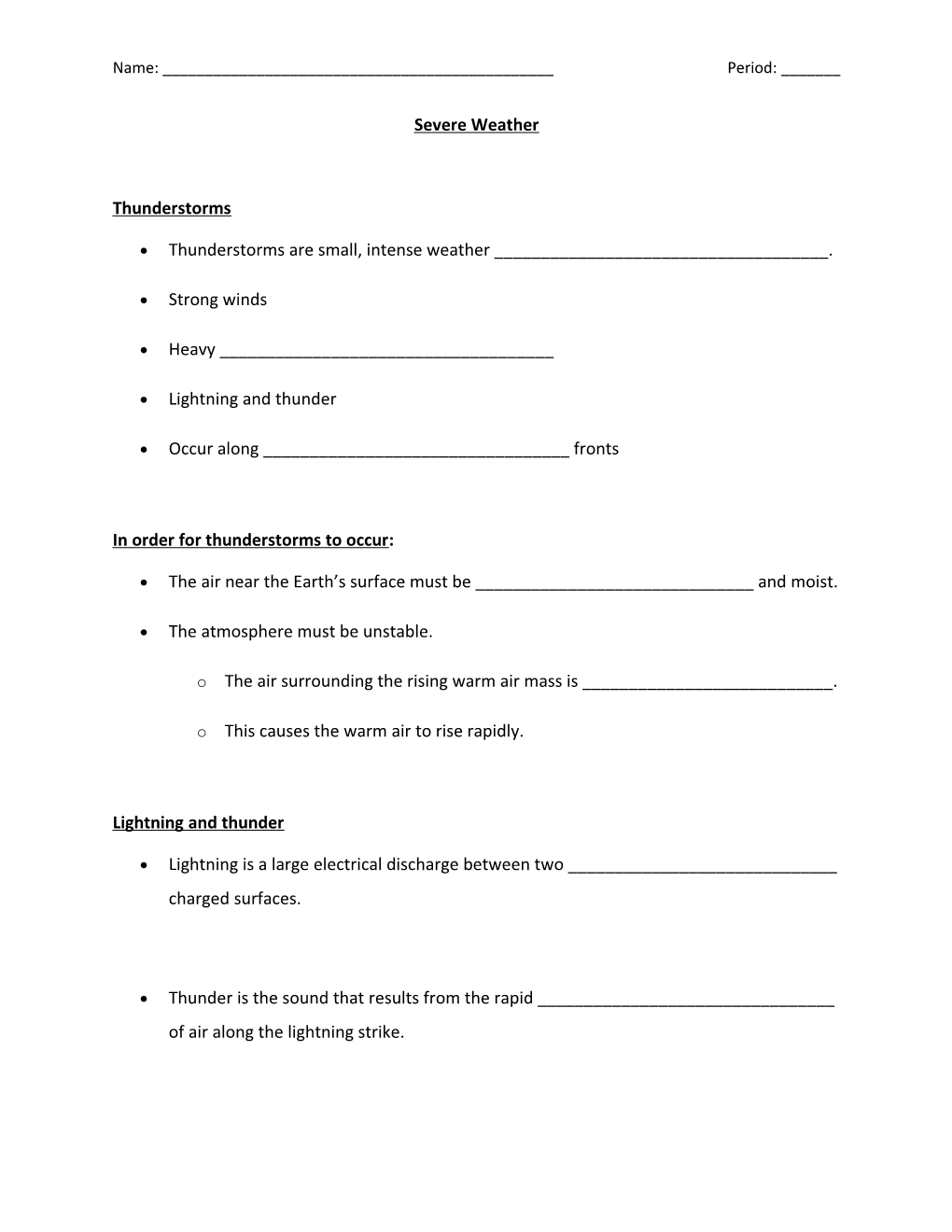Name: ______Period: ______
Severe Weather
Thunderstorms
- Thunderstorms are small, intense weather ______.
- Strong winds
- Heavy ______
- Lightning and thunder
- Occur along ______fronts
In order for thunderstorms to occur:
- The air near the Earth’s surface must be ______and moist.
- The atmosphere must be unstable.
- The air surrounding the rising warm air mass is ______.
- This causes the warm air to rise rapidly.
Lightning and thunder
- Lightning is a large electrical discharge between two ______charged surfaces.
- Thunder is the sound that results from the rapid ______of air along the lightning strike.
How lightning forms diagram:FILL IN THE BLANKS BELOW
Thunderstorm Formation Video:
Thunderstorms are essentially caused by ______in
______and ______.
The electrical disturbances in the atmosphere are caused by the rapid
______of ______.
Tornadoes
- A tornado is a small, rotating ______of air.
- Forms during thunderstorms.
- High wind speeds
- Center of a tornado is called a ______.
- 75 % of a all tornadoes occur in the U.S.
- U.S. averages about ______per year.
Tornado Formation:
- Wind travels in two different directions.
- Air between begins to ______.
- The “roll” turns vertically and begins to rotate because of the ______.
- Turns into a funnel and touches the ground.
Tornado Formation Diagram:
Tornado Video:
How long can tornadoes last? ______
List 2 things you should do if there is a tornado nearby:
- ______
- ______
Tornadoes:
- Waterspouts are tornadoes that form over ______.
- Tornado Alley – an area east of the ______Mountains. It is mainly in Texas, Oklahoma, and Kansas that experiences the highest number of tornadoes per year.
- Why? Cool dry air (north) meets warm moist air (______).
Tornado Alley Diagram:LABEL THE STATES
Fujita Scale:
F-0 40-72 mph, ______damage, tree branches broken
F-1 73-112 mph, mobile homes pushed off foundation or overturned
F-2 113-157 mph, considerable damage, mobile homes demolished, trees ______
F-3 158-205 mph, roofs and walls torn down, trains overturned, cars thrown
F-4 207-260 mph, well-constructed ______leveled
F-5 261-318 mph, homes lifted off foundation and carried considerable distances, ______thrown as far as 100 meters
Fujita Scale Diagram:FILL IN THE BLANKS BELOW
Hurricanes Study Guide
Ingredients for a Hurricane to form:
1. Ocean water temperature ______°or more.
2. Surface level low pressure
3. Upper level high pressure.
So what would cause a hurricane to weaken?
- If the hurricane moves into ______water.
- If the hurricane moves over ______.
Hurricane Development
1. Tropical Wave: a large, ______area of rain.
- This usually forms off the coast of Africa.
- No symbol.
2. Tropical ______: a storm spinning counterclockwise with winds <39 mph.
Symbol is:L
3. Tropical Storm: a storm spinning clockwise with ______between 39 and 73 mph.
Symbol:
4. Hurricane: a storm ______counter clockwise with winds > 74 mph.
Symbol:
Parts of a Hurricane – label the parts in the blanks
Eye – the ______, low pressure center of a hurricane.
- 5-30 miles wide.
Eye wall – the dense wall of ______surrounding the eye.
- The strongest and most intense part of a hurricane.
Rain bands – the spiral bands of ______surrounding the eye wall.
- The largest part of a hurricane
Storm surge – large surge of water near the coast.
- This causes the most ______!
Hurricane season is from ______to ______.
Saffir Simpson Scale
The ______to measure hurricanes is called the Saffir Simpson Scale.
Category 1 is the weakest.
Category 5 is the strongest: winds > 157 mph.
2014 Hurricane Names:
Hurricane Katrina - ______
She was a Category 5 at one point, but she made landfall in U.S. as a category 4.
Hurricane Katrina Formation Video
- How warm was the ocean water when Hurricane Katrina formed? ______
- What category storm was Katrina when she glanced off of Florida? ______
- What made Katrina grow stronger when she went into the Gulf Of Mexico? ______
______
Only 3 Category 5 hurricanes have ever made landfall in the United States:
- 1935 ______Hurricane
- 1969 Hurricane Camille
- ______Hurricane Andrew
